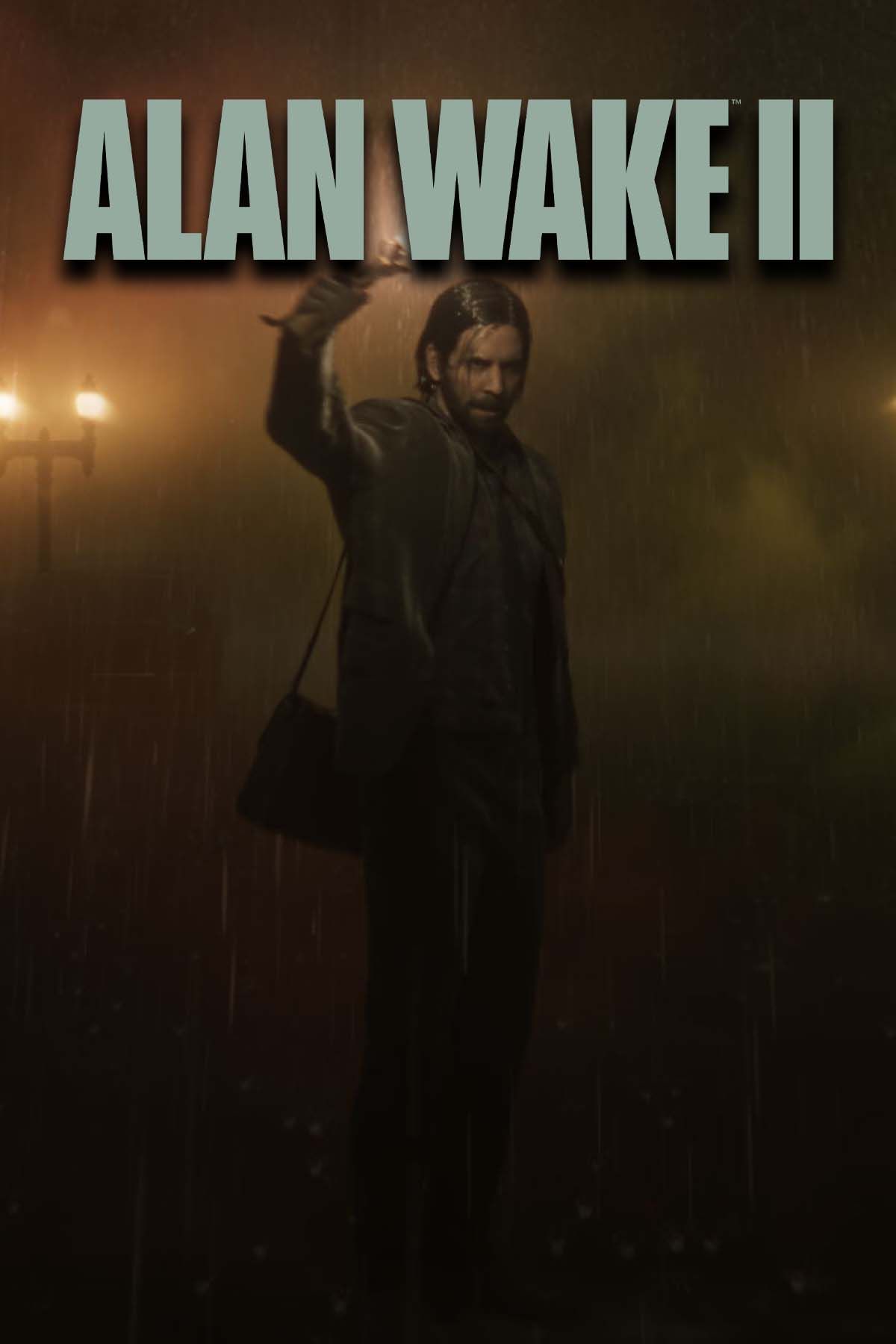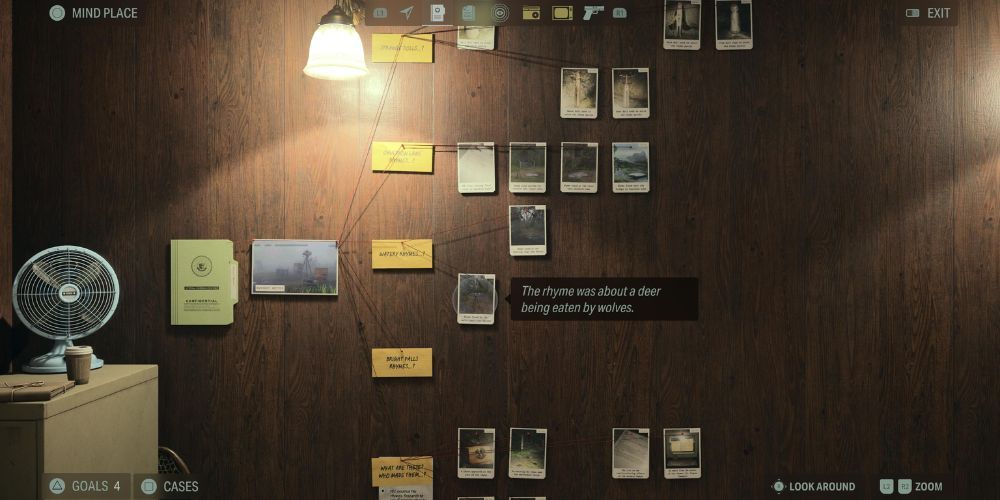
Alan Wake 2
PlayStation 5
Alan Wake 2 is an incredible sequel, fully realizing the ambitious storytelling established in the first game and combining it with fantastic moment-to-moment gameplay. DualShockers was provided a copy of the game for review purposes.
- Released
- October 27, 2023
- Nuanced and immersive storytelling
- Excellent level design
- Clever puzzles
- Tense and unsettling atmosphere
- Occasional frustrating puzzles and navigation
My first brush with Remedy as a developer was fairly recent: Control back in 2019. I loved the surreal nature of the world, the intermixing of the mundane and the supernatural, the fantastic characters, and the incredible power fantasy. I loved the world and setting so much that I went back and played the original Alan Wake because of Control’s upcoming (at the time) AWE expansion, which focused on Alan Wake’s presence in the setting. What I found with the original Alan Wake was that great Remedy storytelling I’d fallen in love with, but the game was dragged down by dated mechanics, often feeling more like a run-and-gun shooter that was completely at odds with its contemplative and eerie tone. Fast-forward 13 years, and Alan Wake 2 not only follows up on the incredibly twisted narrative of the first game in a deeply satisfying way, but also elevates the combat to be just as good as the mind-bending stories being told.
Alan Wake 2 picks up 13 years after the first game left off, mirroring the 13 years between the games’ releases, which is just the kind of pleasing synchronicity I’ve come to expect from Remedy. The small town of Bright Falls has had a string of mysterious murders, and FBI agents Saga Anderson and Alex Casey (played by none other than Max Payne) hit the scene to investigate. As Saga and Casey delve into the case, the supernatural elements creep in, and they’re soon investigating a murder cult in the woods surrounding Cauldron Lake. Meanwhile, Alan Wake himself is right where we left him in 2010: trapped in the Dark Place, trying desperately to write his way out.
When I’d initially heard that Alan Wake 2 would have dual protagonists, I was surprised; the first game was so singularly Alan Wake’s story, both in his narration and in his very specific experience of the game’s events, that I had some concerns about splitting the narrative between two characters. All doubts were quickly laid to rest in the opening moments of the game. Saga Anderson is captivating, offering a fantastic detective experience as you investigate not just the murder cult, but every related mystery you come across, weaving a tapestry of clues and interlinking events to slowly piece together the layered puzzles that surround her. Saga’s rational, straight-laced character grounds the story, balancing it with the ‘mad, rambling writer’ vibes that Alan Wake brings from his desperate bid to escape the Dark Place.
As with the first game, the lines between what’s real and what’s fiction — what is created whole cloth from Wake’s manuscripts and what is modified by him — is intentionally vague and beautifully delivered. Saga encounters multiple people who speak to her as if they’ve known her their whole lives (even though she only just arrived in town), and many conversations have the slightest edge of insanity to them. Remedy are masters at this subtle unease, building a kind of background tension even during quieter moments in the story. Once you’re “through the looking glass,” delving fully into the paranormal, the supernatural elements continue to multiply and spread out, taking over your experience. Saga continues to ground the story in reality, but she’s surrounded by nightmares and darkness as reality literally shifts around her.
Saga brings a real groundedness to the story that is balanced beautifully with the full-on insanity that Alan Wake brings from his desperate bid to escape the Dark Place.
I can’t stress enough just how good the story and writing are. No matter who I was playing as, I was completely enthralled in what was happening, in the mysteries at play. Questioning characters and reviewing the conversation in Saga’s Mind Place makes for a uniquely tactile feel. After speaking with someone, you can retreat into Saga’s Mind Place to consider what you’ve learned, probe for holes in their story, which creates new dialogue opportunities for you to explore. As reality begins to warp and bend around the unfolding narrative, Saga will increasingly need to reflect on conversations she’s having to determine what information matches up with reality as she knows it versus the shifting world around her.
This is mirrored beautifully in the moment-to-moment gameplay as well, starting with the combat. It’s a fair bit slower than the first game’s, pairing beautifully with the game’s tense exploration. Combat is based around using light sources to weaken the Taken/Shadow enemies, making them vulnerable to your gunshots. The is primarily done with your flashlight to sort of burn the darkness out of the enemy, making them vulnerable to follow-up gunshots. In addition, you also gain access to flares, flare guns, propane tanks, and flashbangs (the latter few really come in handy when you’re getting swarmed by five or six shadows at once). The rhythm of flashlight, gunshot, dodge, and repositioning quickly gets burned into your muscle memory as you wind deeper into the game. In addition to Saga’s trusty pistol (or Wake’s signature revolver), you’ll be able to acquire a few additional weapons throughout, like the sawed-off shotgun and the crossbow, each of which offers distinct advantages and disadvantages, depending on the situation.
Enemy variety further complicates many encounters, featuring larger brute-like enemies, knife-throwing speedsters, and shadow-corrupted wolves that will stalk you from the shadows (just to name a few). These deadly encounters are sometimes scripted, sometimes randomly generated, ensuring that the tension is always simmering, ready to boil over at any moment. I found this especially true when playing as Wake. The Dark Place is filled with shadows — dark figures standing around, mostly passive, though at all times unsettling. You can pass through most as if they’re just vapor, but any shadow can suddenly become an enemy. This stokes your paranoia as you make your way through the levels, never quite sure which shadow will suddenly become a threat.
You’ll be navigating a variety of locations, scrounging for ammo, batteries (gotta keep that flashlight working), and supplies in drawers and cabinets, solving small environmental puzzles as you search for you next objective — and your next save point. While playing as Saga, you’ll be navigating several different large maps in the greater Bright Falls areas. From dense forests to abandoned amusement parks, you’ll be following up on leads, searching for clues, and desperately trying to survive and make sense of all that’s unfolding around you. While playing as Alan Wake, you’re navigating the Dark Place’s twisted version of New York City, an ever-changing hellscape warped by Wake’s perception and that of his tormentor, the Dark Presence.
Both Saga Anderson and Alan Wake deal extensively with puzzles, from minor side puzzles off the beaten path to major environmental ones necessary for progression. However, they each have special mechanics that make for drastically different experiences. How they interact with their surroundings feels so distinct; I was constantly in a state of indecision regarding which narrative I wanted to pursue; did I want to travel to the next town over as Saga as she pursues a promising lead in her case, or did I want to delve back into the madness of the Dark Place as Wake, searching for the next plot thread to assemble?
Saga pieces together information through her ‘Mind Place,’ where she can retreat from the events of the game to review clues and notes discovered in the world, drawing connections on a wall with threads cascading between notes, photos, and leads across a myriad of different case files she’s working on. While investigating out in the field, you’ll be uncovering various clues, which you can then assemble in the Mind Place. This leads to further questions, deductions, and eventually leading toward answers, always drilling down toward a greater truth. Profiling is where Saga’s intuition takes on a quasi-supernatural element. She’s able to really get inside someone’s headspace, which comes with some form of deeper insight beyond normal everyday perception skills.
Wake comes with a few fun features too, which serve to enhance the surreal nature of the Dark Place. First, he has the Angel Lamp, a powerful item that can change the lighting in certain areas to alter the world around him. This is often used as a way to navigate complicated areas, as it will allow him to restructure the world to find the right way forward. When reaching a dead-end featuring the signature light source, you can absorb the light into the Angel Lamp, which then rearranges the environment, opening up a new route. This usually leads into another dead-end where you can utilize the recently acquired light to perform a similar transformation, untangling the layers of the world to form a clear path forward.
In searching for a way out of the Dark Place, he must visit various locations to continue writing his story. When he enters a new area and collects enough information, he can then apply different plot points to each location, changing the theme and structure of the setting to allow him to access different areas around a map, gain new insight into the world around him, and generally delve deeper into madness as he traverses layers of alternate realities stacked on top of one another.
While navigating the Oceanview Hotel, for example, I was attempting to reach a specific room on a higher floor to advance the narrative. This involved searching the lower floors, gathering information, and making discoveries about the theoretical murder plot that took place in the building. The way forward was blocked, but after discovering that the cultists met in a specific locked room earlier in the day, I applied a plot point involving a sort of pre-show ritual that took place in that room, changing the setting to reflect that moment in time. This opened up access to that room, which then led me deeper into this temporal maze. The search for the ‘correct’ plot point is a fascinating one, intentionally full of backtracks and false-starts as you try to figure out the best narrative to reach the end.
Alan Wake 2 feels like the culmination of the hard work Remedy has been putting into their distinct style of storytelling for decades now.
Throughout the game, you’ll alternate back and forth between Saga and Alan’s storylines. Once you unlock both, you’ll be able to swap back and forth at specific save points through each character’s journey, allowing you quite a bit of freedom to take the story at your pace. I found myself mainly switching back and forth after a major chapter came to a close, but no matter what I did, I struggled with the choice every time. Their stories offer extremely different experiences, but both are equally enthralling. You could stick with one character’s story for multiple chapters in a row, digging further into their specific events at a more rapid pace, but I found swapping back and forth regularly felt just right, as their stories overlap in interesting ways, both thematically and literally.
Do you need to play the original Alan Wake and Control to enjoy Alan Wake 2? No. The story works perfectly well without having played those. You won’t catch all the fun references and Easter eggs, but the narrative itself is intentionally confusing, even if you’re ‘in the know.’ Layers upon layers of mysteries pile up, so missing some of those references or name-drops doesn’t spoil the experience. Having said that, I’d strongly recommend finding a quick recap on the story and characters from the first Alan Wake game at least. Alan Wake 2 offers such a rich narrative follow-up to the previous game, it’s hard to not want to completely devour every bit possible.
Alan Wake 2 feels like the culmination of the hard work Remedy has been putting into their distinct style of storytelling for decades now. The writing is clever, the characters are compelling, and the mysteries kept me guessing up until the very end. What this game accomplished with such a bizarre story concept is, frankly, remarkable. The subject matter is messy and complicated, but it’s always presented in such an interesting and engaging way. Mysteries are drip-fed at a perfect pace, and several reveals left me genuinely pleased. Alan Wake 2 might not tie every plot thread in a neat bow by the end, leaving some mysteries for the imagination (and future titles, no doubt), but the game marks a new core pillar in the Remedyverse.
The writing is lovingly meta throughout, as the plot itself regularly deals with concepts that should defy reason, and yet everything is laid out in such a digestible and entertaining way. I instantly became a fan of Remedy’s work in 2019 when I Platinum’ed Control. Alan Wake 2 solidified for me that Remedy is a developer I can trust deeply to deliver a thoughtful, high concept narrative that delves into dark and unsettling territory while balancing that with well-placed humor and levity. The characters know that they’re experiencing absurdities along with the horrors, and that somehow makes the impossible all the more real.

